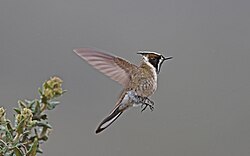Biology:Bearded helmetcrest
| Bearded helmetcrest | |
|---|---|

| |
| Green-bearded helmetcrest, Oxypogon guerinii | |
| Scientific classification Error creating thumbnail: Unable to save thumbnail to destination
| |
| Domain: | Eukaryota |
| Kingdom: | Animalia |
| Phylum: | Chordata |
| Class: | Aves |
| Clade: | Strisores |
| Order: | Apodiformes |
| Family: | Trochilidae |
| Tribe: | Lesbiini |
| Genus: | Oxypogon Gould, 1848 |
| Type species | |
| Ornismya guerinii Boissonneau, 1840
| |
| Species | |
|
see text | |
The bearded helmetcrests (Oxypogon) are a genus of hummingbird in the family Trochilidae. They are found in Colombia and Venezuela. Primary natural habitat is subtropical or tropical high-altitude grassland, known as páramo. The genus contains four species.
Taxonomy and species list
The genus Oxypogon was introduced in 1848 by the English ornithologist John Gould.[1] The type species was subsequently designated as the green-bearded helmetcrest.[2][3] The genus name combines the Ancient Greek oxus meaning "sharp" or "pointed" with pōgōn meaning "beard".[4]
The genus contains four species:[5]
- White-bearded helmetcrest, Oxypogon lindenii
- Green-bearded helmetcrest, Oxypogon guerinii
- Blue-bearded helmetcrest, Oxypogon cyanolaemus
- Buffy helmetcrest, Oxypogon stuebelii
These four species were formerly all considered as subspecies of what was known as the bearded helmetcrest (Oxypogon guerinii). The bearded helmetcrest was split into four separate species based on a study of biometric and plumage data published in 2013.[5][6]
A study of mitochondrial DNA of hummingbirds shows it to be most closely related to the bearded mountaineer (Oreonympha nobilis) and the rufous-capped thornbill (Chalcostigma ruficeps). The other member of the genus Chalcostigma lay outside the group, suggesting the genus might need revising in the future.[7]
Description
The most common species, the white-bearded helmetcrest, measures 11.4 cm (4.5 in) in length, it is a small hummingbird with a very small 8 mm (0.31 in) bill. The adult male has a distinctive pointed black crest and a shaggy white beard. The face and cheeks are blackish, rendering a triangular shape with the white fronted crest and white beard. The underparts are a dull green-grey. The female lacks the beard and crest.[8][9]
The species of bearded helmetcrests are found in the Andes, ranging from altitudes of 3,600 to 4,500 m (11,800 to 14,800 ft) in Venezuela,[9] and 3,200 to 5,200 m (10,500 to 17,100 ft) in Colombia.[8] Its main habitat is the páramo, but can descend to the treeline outside of breeding season.[9]
All species often perch on boulders and flit between low-flowering shrubs, visiting the flowers of the genera Espeletia, Echeveria, Siphocampylus, Castilleja and Draba.[9]
All species breed during the rainy season, and nest in the daisy Espeletia or build a nest of material from the daisy in a cliff or bank.[9]
References
- ↑ Gould, John (1848). "Drafts for a new arrangement of the Trochilidae". Proceedings of the Zoological Society of London Part 16 (180): 11–14 [14]. https://www.biodiversitylibrary.org/page/12861850.
- ↑ Gray, George Robert (1855). Catalogue of the Genera and Subgenera of Birds Contained in the British Museum. London: British Museum. p. 22. https://www.biodiversitylibrary.org/page/17136642.
- ↑ Peters, James Lee, ed (1945). Check-List of Birds of the World. 5. Cambridge, Massachusetts: Harvard University Press. p. 122. https://www.biodiversitylibrary.org/page/14480133.
- ↑ Jobling, James A. (2010). The Helm Dictionary of Scientific Bird Names. London: Christopher Helm. p. 287. ISBN 978-1-4081-2501-4.
- ↑ 5.0 5.1 Gill, Frank; Donsker, David; Rasmussen, Pamela, eds (July 2020). "Hummingbirds". IOC World Bird List Version 10.2. International Ornithologists' Union. http://www.worldbirdnames.org/bow/hummingbirds/. Retrieved 2 January 2020.
- ↑ Collar, Nigel J.; Salaman, Paul (2013). "The taxonomic and conservation status of the Oxypogon helmetcrests". Conservación Colombiana 19: 31–38. https://proaves.org/wp-content/uploads/2013/12/The-taxonomic-and-conservation-status-of-the-Oxypogon-helmetcrests.pdf.
- ↑ McGuire, Jimmy A.; Witt Christopher C.; Remsen, J. V. Jr; Dudley R.; Altshuler, Douglas L. (2008). "A higher-level taxonomy for hummingbird". Journal of Ornithology 150: 155–65. doi:10.1007/s10336-008-0330-x. http://www.msb.unm.edu/birds/publications/McGuire_etal_2008_J.Ornithol._Trochilid_Taxonomy.pdf.
- ↑ 8.0 8.1 Steven L. Hilty; Bill Brown (1986). A guide to the birds of Colombia. Princeton University Press. p. 295. ISBN 0-691-08372-X. https://books.google.com/books?id=kHa6tJNKGDAC&dq=Bearded+Helmetcrest&pg=PA295. Retrieved 12 June 2011.
- ↑ 9.0 9.1 9.2 9.3 9.4 Steven L. Hilty; Rodolphe Meyer de Schauensee (2003). Birds of Venezuela. Princeton University Press. p. 432. ISBN 0-691-09250-8. https://books.google.com/books?id=40mFwoALUFUC&dq=Bearded+Helmetcrest&pg=PA432. Retrieved 12 June 2011.
Wikidata ☰ Q10803544 entry
 |

